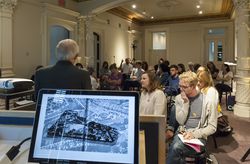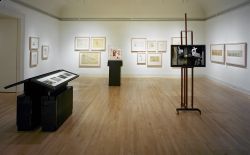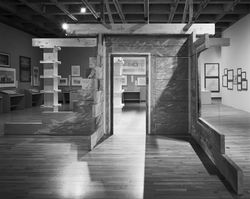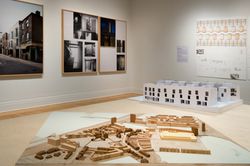PHCON2002:0016:005
Description:
Binder consists of published documentation on the work of Gordon Matta-Clark from the period from 1971 to 1977. It includes exhibition catalogues, reviews of exhibitions, and published interviews; these include documentation on Alternatives to the Washington Square Art Fair (1973) ; Anarchitecture (1973-1974); A W-Hole House (1973); Bingo (1974); City Slivers (1976); Conical Intersect (1975); Contrabienal (1971); Day's End (1975); Fresh Air Cart (1972); Jacks (1971); Jacob's Ladder (1977); Meander (1976); Office Baroque (1977); Open House (1972); Underground Paris (1977); Subway Graffiti (1973); Splitting (1974); Tree Dance (1971); and Walls Paper (1972). Photographs, both personal and those created for publicity, are contained in the binder, as well as correspondence and an example of a Certificate of Authenticity created to give to purchasers of his works. Also included are a series of different resumes written by Matta-Clark along with a more extensive posthumous curriculum vitae and a list of the books in his library. Binder contains photographs, slides and textual records.
1971-1977
Reviews, Announcements, Catalogues & Photos 1970-77
Actions:
PHCON2002:0016:005
Description:
Binder consists of published documentation on the work of Gordon Matta-Clark from the period from 1971 to 1977. It includes exhibition catalogues, reviews of exhibitions, and published interviews; these include documentation on Alternatives to the Washington Square Art Fair (1973) ; Anarchitecture (1973-1974); A W-Hole House (1973); Bingo (1974); City Slivers (1976); Conical Intersect (1975); Contrabienal (1971); Day's End (1975); Fresh Air Cart (1972); Jacks (1971); Jacob's Ladder (1977); Meander (1976); Office Baroque (1977); Open House (1972); Underground Paris (1977); Subway Graffiti (1973); Splitting (1974); Tree Dance (1971); and Walls Paper (1972). Photographs, both personal and those created for publicity, are contained in the binder, as well as correspondence and an example of a Certificate of Authenticity created to give to purchasers of his works. Also included are a series of different resumes written by Matta-Clark along with a more extensive posthumous curriculum vitae and a list of the books in his library. Binder contains photographs, slides and textual records.
1971-1977
Le CCA présente Outils daujourdhui 2014, un séminaire dété tenu dans le cadre du Programme de subventions de recherche dans la Collection CCA-Groupe Banque TD. Cette année, le séminaire abordes des questions en architecture contemporaine en montrant comment des projets divergent et senrichissent mutuellement, et comment leur différences résultent de points de vue(...)
23 juin 2014 au 28 juin 2014
Outils d’aujourd’hui : Matériels et atmosphères
Actions:
Description:
Le CCA présente Outils daujourdhui 2014, un séminaire dété tenu dans le cadre du Programme de subventions de recherche dans la Collection CCA-Groupe Banque TD. Cette année, le séminaire abordes des questions en architecture contemporaine en montrant comment des projets divergent et senrichissent mutuellement, et comment leur différences résultent de points de vue(...)
L’exposition se concentre sur un aspect déterminant et actuel de l’œuvre de Scarpa : l’approche originale qu’il utilisait pour composer avec les strates historiques qui forment le tissu d’une ville ou d’un bâtiment. En se concentrant sur l’habileté avec laquelle Scarpa pouvait développer une nouvelle œuvre à l’intérieur même, et souvent à partir, de fragments disparates(...)
Salles principales
26 mai 1999 au 31 octobre 1999
Carlo Scarpa, architecte : composer avec l’histoire
Actions:
Description:
L’exposition se concentre sur un aspect déterminant et actuel de l’œuvre de Scarpa : l’approche originale qu’il utilisait pour composer avec les strates historiques qui forment le tissu d’une ville ou d’un bâtiment. En se concentrant sur l’habileté avec laquelle Scarpa pouvait développer une nouvelle œuvre à l’intérieur même, et souvent à partir, de fragments disparates(...)
Salles principales
Projet
BMI/HQ
AP144.S2.D74
Description:
File documents the unexecuted design for the headquarters of the Birmingham and Midland Institute (BMI), in Birmingham, England. This project is related to the Shantasea Development (AP144.S2.D72) from which Cedric Price resigned as architect to take on the role of architect for BMI, one of the proposed tenants for the Shantasea project. Cedric Price proposed a municipal and regional "nerve centre" to house seminar and study rooms, workshops, galleries, film, television and music studios, a library, a planetarium, and a theatre. A flexible life-cycle plan (expansion, static, contraction) for the building and the activities would allow BMI to expand in the short and medium term, and to shrink in the long term, when it was assumed that many of its roles would be replaced by the UK's Open University plan (Works II, 42). Work on the project came to a stop in 1970 under a new city council (Architectural Design, June 1971, 368). Existing conditions material consists of maps and a survey of Birmingham. Conceptual sketches and drawings include: annotated diagrammatic plans and sections used to develop the building's massing and the horizontal/vertical relationships between functional areas; axonometric views showing the building's general form/functions; plans used for calculating square footage; diagrams showing visual and physical movement through the building; information and movement charts; and flow charts showing the building's organization. Design development drawings consist of graphs showing how functional areas might be used over time. Design development and working drawings include: diagrammatic plans and sections; exploded axonometric views of the functional relationships between areas; exterior axonometric views; sectional perspectives; space allocation plans; circulation drawings; diagrams showing activities throughout the day; furniture equipment schedules; theatre seating and stair studies; and elevations for exterior cladding. Charts show links between activities/actions; activity distribution; activity/capacity; progress of pre-contract work; and the telephone network. File also includes drawings by engineering consultants Felix Samuely and Partners and Zisman, Bowyer and Partners. Presentation material includes: newspaper clippings and text concerning the project; diagrammatic plans, sections, and charts; and a photo collage of the site; and a text by Cedric Price entitled "The Present Position". Some materials in this file were published in "Cedric Price Supplement No. 3", 'Architectural Design', vol. 41, (June 1971), 364-368, and 'Cedric Price-Works II' (London: Architectural Press, 1984), 36, 42. Material in this file was produced between 1967 and 1971. Zisman Bowyer and Partners appear as the mechanical and electrical consulting engineers; Silk and Frazier as the quantity surveyors; and Versa-Serve Ltd as the catering consultants on this project. File contains cartographic materials, conceptual drawings, design development drawings, panels, photographic materials, presentation drawings, presentation panels, publication drawings, technical drawings, and textual records.
1967-1971
BMI/HQ
Actions:
AP144.S2.D74
Description:
File documents the unexecuted design for the headquarters of the Birmingham and Midland Institute (BMI), in Birmingham, England. This project is related to the Shantasea Development (AP144.S2.D72) from which Cedric Price resigned as architect to take on the role of architect for BMI, one of the proposed tenants for the Shantasea project. Cedric Price proposed a municipal and regional "nerve centre" to house seminar and study rooms, workshops, galleries, film, television and music studios, a library, a planetarium, and a theatre. A flexible life-cycle plan (expansion, static, contraction) for the building and the activities would allow BMI to expand in the short and medium term, and to shrink in the long term, when it was assumed that many of its roles would be replaced by the UK's Open University plan (Works II, 42). Work on the project came to a stop in 1970 under a new city council (Architectural Design, June 1971, 368). Existing conditions material consists of maps and a survey of Birmingham. Conceptual sketches and drawings include: annotated diagrammatic plans and sections used to develop the building's massing and the horizontal/vertical relationships between functional areas; axonometric views showing the building's general form/functions; plans used for calculating square footage; diagrams showing visual and physical movement through the building; information and movement charts; and flow charts showing the building's organization. Design development drawings consist of graphs showing how functional areas might be used over time. Design development and working drawings include: diagrammatic plans and sections; exploded axonometric views of the functional relationships between areas; exterior axonometric views; sectional perspectives; space allocation plans; circulation drawings; diagrams showing activities throughout the day; furniture equipment schedules; theatre seating and stair studies; and elevations for exterior cladding. Charts show links between activities/actions; activity distribution; activity/capacity; progress of pre-contract work; and the telephone network. File also includes drawings by engineering consultants Felix Samuely and Partners and Zisman, Bowyer and Partners. Presentation material includes: newspaper clippings and text concerning the project; diagrammatic plans, sections, and charts; and a photo collage of the site; and a text by Cedric Price entitled "The Present Position". Some materials in this file were published in "Cedric Price Supplement No. 3", 'Architectural Design', vol. 41, (June 1971), 364-368, and 'Cedric Price-Works II' (London: Architectural Press, 1984), 36, 42. Material in this file was produced between 1967 and 1971. Zisman Bowyer and Partners appear as the mechanical and electrical consulting engineers; Silk and Frazier as the quantity surveyors; and Versa-Serve Ltd as the catering consultants on this project. File contains cartographic materials, conceptual drawings, design development drawings, panels, photographic materials, presentation drawings, presentation panels, publication drawings, technical drawings, and textual records.
File 74
1967-1971
archives
Niveau de description archivistique:
Fonds
Joseph Rykwert fonds
AP209
Résumé:
The Joseph Rykwert fonds, 1928-2022, documents Joseph Rykwert’s career as an architectural historian, author and professor. The fonds includes the records for over a dozen monographs written between the mid-1960s and the mid-2010s as well as edited works and articles, and details his teaching and lecturing activities from the 1960s onwards in universities in Europe and the United States. The records highlight Joseph Rykwert’s multidisciplinary approach, which involved archaeology, anthropology and psychoanalysis in his study of the history and theory of architecture and of the urban form. The fonds is composed of textual records, publications and ephemera, and of photographs including multiple albums and a large number of slides; the fonds also documents Joseph Rykwert’s career as an independent designer through drawings realized between the late 1940s and the late 1970s.
1928-2022
Joseph Rykwert fonds
Actions:
AP209
Résumé:
The Joseph Rykwert fonds, 1928-2022, documents Joseph Rykwert’s career as an architectural historian, author and professor. The fonds includes the records for over a dozen monographs written between the mid-1960s and the mid-2010s as well as edited works and articles, and details his teaching and lecturing activities from the 1960s onwards in universities in Europe and the United States. The records highlight Joseph Rykwert’s multidisciplinary approach, which involved archaeology, anthropology and psychoanalysis in his study of the history and theory of architecture and of the urban form. The fonds is composed of textual records, publications and ephemera, and of photographs including multiple albums and a large number of slides; the fonds also documents Joseph Rykwert’s career as an independent designer through drawings realized between the late 1940s and the late 1970s.
archives
Niveau de description archivistique:
Fonds
1928-2022
L’exposition révèle trois aspects des villas décrites par l’écrivain romain Pline le Jeune au Ier siècle après J.-C. : l’influence historique directe de ces villas sur l’architecture; l’influence indirecte qu’elles ont exercé sur les architectes en leur offrant un modèle d’étude; et leurs effets sur la tradition classique véhiculée à Montréal. Les villas de Pline et les(...)
Musée des beaux-arts de Montréal
14 octobre 1983 au 11 décembre 1983
Les villas de Pline et les éléments classiques dans l'architecture à Montréal
Actions:
Description:
L’exposition révèle trois aspects des villas décrites par l’écrivain romain Pline le Jeune au Ier siècle après J.-C. : l’influence historique directe de ces villas sur l’architecture; l’influence indirecte qu’elles ont exercé sur les architectes en leur offrant un modèle d’étude; et leurs effets sur la tradition classique véhiculée à Montréal. Les villas de Pline et les(...)
Musée des beaux-arts de Montréal
L’Esprit nouveau : l’architecture moderne à Vancouver, 1938–1963, étudie les bâtiments et les ensembles marquants de cette période passionnante de l’histoire de Vancouver. L’exposition réunit des dessins de conception et des photographies d’époque ainsi que des éléments de mobilier et de décoration. Au sortir de la Seconde Guerre mondiale, Vancouver s’affirme comme une(...)
Salles principales
5 mars 1997 au 25 mai 1997
L'Esprit nouveau : l'architecture moderne à Vancouver, 1938-1963
Actions:
Description:
L’Esprit nouveau : l’architecture moderne à Vancouver, 1938–1963, étudie les bâtiments et les ensembles marquants de cette période passionnante de l’histoire de Vancouver. L’exposition réunit des dessins de conception et des photographies d’époque ainsi que des éléments de mobilier et de décoration. Au sortir de la Seconde Guerre mondiale, Vancouver s’affirme comme une(...)
Salles principales
archives
Niveau de description archivistique:
Fonds
AP196
Résumé:
Studio Gang Ford Calumet Environmental Center project records, 2003-2012, documents the design process for the Ford Calumet Environmental Center in Chicago, United-States. The records represent both phases during the competition and the full-term design, after the firm won the project. The records consist of born-digital material, sketches and drawings, textual records, photographs and seven models.
2003-2011
Documents d’archives de Studio Gang pour le projet Ford Calumet Environmental Center
Actions:
AP196
Résumé:
Studio Gang Ford Calumet Environmental Center project records, 2003-2012, documents the design process for the Ford Calumet Environmental Center in Chicago, United-States. The records represent both phases during the competition and the full-term design, after the firm won the project. The records consist of born-digital material, sketches and drawings, textual records, photographs and seven models.
archives
Niveau de description archivistique:
Fonds
2003-2011
Cette exposition se consacre aux projets architecturaux récents de Stephen Taylor à Londres et de Ryue Nishizawa à Tokyo, qui proposent de nouvelles approches de la vie en milieu urbain. Perspectives de vie à Londres et à Tokyo imaginées par Stephen Taylor et Ryue Nishizawa marque la première présentation en Amérique du Nord des projets résidentiels de Taylor et Nishizawa(...)
Salles principales
14 mai 2008 au 26 octobre 2008
Perspectives de vie à Londres et à Tokyo imaginées par Stephen Taylor et Ryue Nishizawa
Actions:
Description:
Cette exposition se consacre aux projets architecturaux récents de Stephen Taylor à Londres et de Ryue Nishizawa à Tokyo, qui proposent de nouvelles approches de la vie en milieu urbain. Perspectives de vie à Londres et à Tokyo imaginées par Stephen Taylor et Ryue Nishizawa marque la première présentation en Amérique du Nord des projets résidentiels de Taylor et Nishizawa(...)
Salles principales
archives
Niveau de description archivistique:
Fonds
AP106
Résumé:
The Faubourg Québec project records, 1989-1994, document the redevelopment of Faubourg Québec, a 30 acre site east of the Old Port of Montréal, into an urban residential neighbourhood. Materials in these project records consist of approximately 253 drawings (including reprographic copies) and 0.33 of l.m. textual materials.
1989-1994
Documents d’archives pour le projet Faubourg Québec
Actions:
AP106
Résumé:
The Faubourg Québec project records, 1989-1994, document the redevelopment of Faubourg Québec, a 30 acre site east of the Old Port of Montréal, into an urban residential neighbourhood. Materials in these project records consist of approximately 253 drawings (including reprographic copies) and 0.33 of l.m. textual materials.
archives
Niveau de description archivistique:
Fonds
1989-1994




